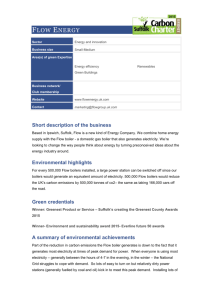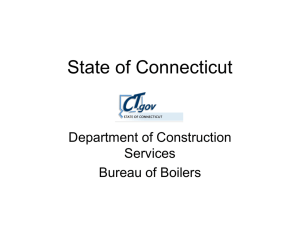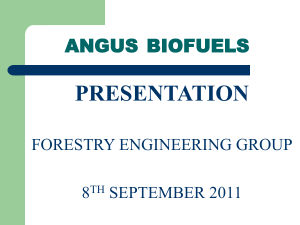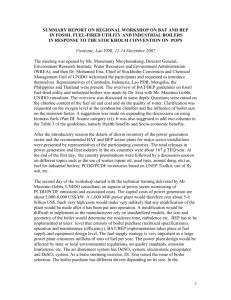Safety Rules and Regulations
advertisement
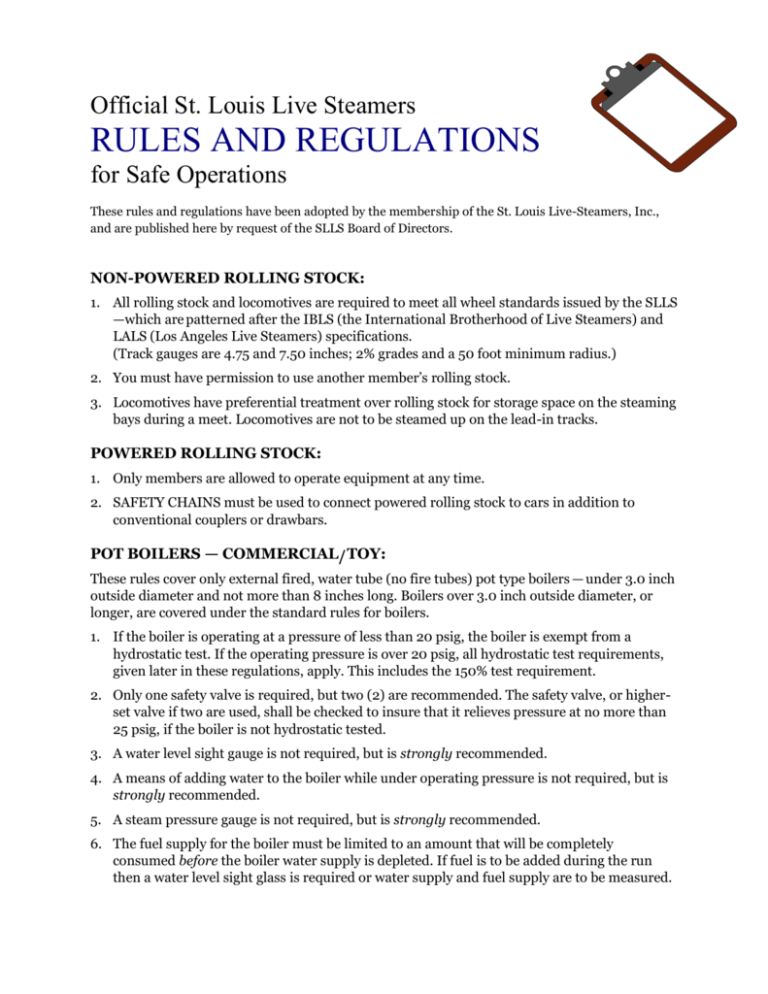
Official St. Louis Live Steamers RULES AND REGULATIONS for Safe Operations These rules and regulations have been adopted by the membership of the St. Louis Live-Steamers, Inc., and are published here by request of the SLLS Board of Directors. NON-POWERED ROLLING STOCK: 1. All rolling stock and locomotives are required to meet all wheel standards issued by the SLLS —which are patterned after the IBLS (the International Brotherhood of Live Steamers) and LALS (Los Angeles Live Steamers) specifications. (Track gauges are 4.75 and 7.50 inches; 2% grades and a 50 foot minimum radius.) 2. You must have permission to use another member’s rolling stock. 3. Locomotives have preferential treatment over rolling stock for storage space on the steaming bays during a meet. Locomotives are not to be steamed up on the lead-in tracks. POWERED ROLLING STOCK: 1. Only members are allowed to operate equipment at any time. 2. SAFETY CHAINS must be used to connect powered rolling stock to cars in addition to conventional couplers or drawbars. POT BOILERS — COMMERCIAL/ TOY: These rules cover only external fired, water tube (no fire tubes) pot type boilers — under 3.0 inch outside diameter and not more than 8 inches long. Boilers over 3.0 inch outside diameter, or longer, are covered under the standard rules for boilers. 1. If the boiler is operating at a pressure of less than 20 psig, the boiler is exempt from a hydrostatic test. If the operating pressure is over 20 psig, all hydrostatic test requirements, given later in these regulations, apply. This includes the 150% test requirement. 2. Only one safety valve is required, but two (2) are recommended. The safety valve, or higherset valve if two are used, shall be checked to insure that it relieves pressure at no more than 25 psig, if the boiler is not hydrostatic tested. 3. A water level sight gauge is not required, but is strongly recommended. 4. A means of adding water to the boiler while under operating pressure is not required, but is strongly recommended. 5. A steam pressure gauge is not required, but is strongly recommended. 6. The fuel supply for the boiler must be limited to an amount that will be completely consumed before the boiler water supply is depleted. If fuel is to be added during the run then a water level sight glass is required or water supply and fuel supply are to be measured. LOCOMOTIVE AND STATIONARY BOILERS: 1. All boilers operated at the club site, other than “toy” boilers as already noted, must have passed a hydrostatic test within one year of the date of operation and have been issued a valid boiler inspection certificate by the SLLS or other recognized organization adhering to boiler test requirements at least equivalent to those of the SLLS. 2. Two (2) boiler steam safety valves are required. While the boiler is under steam, these safety valves shall open and hold the steam pressure at not more than 105% of the working pressure, or they must be replaced with safety valves capable of relieving the pressure. Working pressure is the maximum normal operating pressure. 3. All boilers are to have at least two (2) methods of introducing water into the boiler while the boiler is under steam pressure. 4. A boiler steam pressure gauge is required. This gauge shall be checked against the reference gauge on the hydrostatic pressure test pump. The steam pressure gauge reading shall be accurate to ± 10% of the actual pressure, at the working pressure, as shown on the reference pressure gauge during the boiler inspection and test procedures. 5. A water level sight gauge must be installed on the boiler. For this water level gauge, the lowest possible visual reading, or a clearly marked red line that is easy to read, must be a safe distance above the boiler crown sheet to ensure that water is always above the crown sheet under all operating conditions, including operation on a descending gradient. 6. No boilers constructed using soft solder (solders containing lead) will be allowed to operate at the SLLS track site. Boilers must be silver brazed or welded. 7. A St. Louis Live Steamers Safety Committee member, or any SLLS club officer, shall have the authority to prohibit operation of any boiler which does not meet the aforesaid requirements or is judged to be unsafe for any reason. ELECTRIC BATTERY HANDLING: 1. All battery enclosures shall have ventilation holes at the top and sides or the top and bottom of the body. 2. No batteries shall be stored at the club track site between November 1st and April 30th. 3. Power to the battery charger must be turned off when being connected to or disconnected from the battery. 4. There shall be no smoking in the area when batteries are being charged. 5. Extreme caution must be used when testing batteries using a load meter, hydrometer or when adding electrolyte fluid or water. These operations must be done outside of any buildings at the club site. Safety glasses must be worn during these operations. HANDLING LIQUID FUELS — GASOLINE, FUEL OIL, ALCOHOL AND LIQUEFIED PROPANE: 1. Refueling liquid fuel-fired equipment must be done outside of any buildings. 2. Fuel must be stored in government or national safety testing organization approved containers. Fuel containers cannot be stored inside any buildings at the track site and must be labeled with contents and owners name. 3. Fuel cannot be left for storage at the club site overnight except as approved by the SLLS safety committee, and then only outside of all buildings. 4. LPG (propane) cylinders cannot be refilled at the track. No homemade LPG cylinders are allowed. 5. Refueling gasoline-powered locomotives must be done in a safe manner — the engine must be stopped and the ignition off. The engine must be allowed to cool to ambient temperature before refueling operations commence. 6. No smoking during refueling. No smoking when fuel is being transported or transferred in any manner. 7. All fuel storage compartments shall have sufficient size ventilation holes at the top and sides or the top and bottom to prevent the build up of vapors. 8. Any containers of liquid fuel found improperly stored, or stored inside of any SLLS building, will be removed by the safety committee. HYDROSTATIC TEST/ BOILER INSPECTION PROCEDURE: 1. The St. Louis Live Steamers will provide a pump apparatus with a certified test gauge which is the reference gauge for the test procedure. 2. If the locomotive steam gauge has a sufficient working pressure range it shall be left in place during the test and a record made of its accuracy at the working pressure and at the maximum test pressure. If its range is not high enough to withstand the full test pressure (150% of working pressure) this gauge shall be removed and tested against the reference pressure gauge separately. 3. The owner, or a representative designated by the owner, will apply the test pressure, i.e. "pump the handle". 4. At the maximum test pressure the boiler should show no signs of bulging of the boiler shell, crown sheet, or front and rear tube sheets, leakage from tubes or seams, unusual sounds or behavior, or any sudden drop in pressure either while building up pressure or while holding at the maximum pressure. 5. The maximum test pressure will be held on the boiler until both SLLS members serving as witnesses are satisfied with the test results. 6. Slight weeps at the throttle valve packing or other external fittings will not disqualify the boiler under test. 7. The testing of the boiler will be in accord with the information given in the next section of these rules and regulations. HYDROSTATIC TEST/ BOILER INSPECTION INFORMATION: 1. All new boilers shall be hydrostatic tested to a pressure of not less than 200% of the working pressure before being placed in operation. Working pressure is defined as the maximum normal operating pressure and is the pressure at which the lower-set safety valve releases. New is defined as any boiler not having been tested and a boiler certificate issued within the preceding thirty (30) months by the SLLS or other organization recognized by the SLLS. 2. All boilers shall be retested to a pressure of not less than 150% of the working pressure no less often than every 12 months. No boiler can be operated on SLLS property without a valid boiler inspection certificate. 3. Those operating a boiler at the club site that has not been tested by the SLLS will be required to have a valid boiler test certificate issued by another recognized organization that runs tests compatible to, or stricter than, those of the SLLS and which keeps a permanent record of the test. A person not affiliated with another club that conducts boiler tests or who lacks adequate documentation must meet the SLLS test requirements. If the boiler cannot meet the above requirements, that boiler will not be allowed to operate at the club site. 4. The boiler owner shall supply gags, plugs or caps for the safety valves and any other openings or accessories not to be subjected to pressure during the test. 5. A 1/8" NPT female connection is to be supplied on the boiler for the attachment of a 1/8" NPT male threaded connector on the testing equipment. 6. The owner shall fill out and file all necessary reports and records of the testing and two SLLS members shall sign the test certificate as witnesses to the test. 7. The original test certificate shall be given to the club owner and a copy will be kept by the SLLS for its record. 8. Subsequent safe operation of the tested boiler is the owner’s responsibility.
